Laura Flynn McCarthy, KnowMore.tv ~ What does the face of a bully look like? Is it the angry kid in the school yard, or the mocking teen avatar on Facebook?Look closer: The face of a bully, it turns out, may be your own child—taunting your other child. Siblings can do real damage to each other, a new study reveals.
“In our society there are strong norms that bullying is unacceptable between peers whereas between siblings it’s considered normal,” says lead author Corinna Tucker, Ph.D., associate professor of family studies at the University of New Hampshire (UNH). “It’s dismissed as ‘sibling rivalry’ and not such a bad thing. Our study showed that children of all ages and developmental stages who experienced even mild physical or verbal bullying by their sibling felt lower well-being and greater mental distress. The more types of aggression that a child endured from a sibling, the greater the level of mental distress.”
UNH researchers analyzed a nationwide survey that included telephone interviews with almost 3600 youth ages 10 to 17, as well as caregivers of children up to age 9, about sibling relationships. They found that children who reported either physical or psychological bullying by their sibling exhibited similar mental distress to kids who were bullied by peers. What’s more, kids who were bullied by both a sibling and peers showed the most mental distress of all.
“Sibling relationships are emotionally intense,” says Tucker. “Siblings can feel lots of love, but at the same time such hatred for each other. It may be time to rethink the norms around sibling aggression.”

Sibling bullying: When to step in
Sometimes it’s best to let your kids work out disagreements on their own. But at other times you really need to intervene. That’s true if one of your children is always picked on and the other is always the aggressor, or ifdisputes are especially heated. It’s especially important if one of your kids displays symptoms of anxiety,depression or anger, such as withdrawing to their room, lashing out physically, or appearing nervous or afraid. “If you don’t—and especially if your child is also getting picked on at school—that child never has a safe haven,” says KnowMoreTV child/teen development specialist Robyn Silverman, Ph.D. “When you intervene, it’s important not to solve your children’s disputes for them. Instead, act as a coach and usedisputes as chances to teach lessons in conflict resolution and problem-solving.”
Here’s how:
1. First, cool things down. “Break and breathe,” says Dr. Silverman. “Separate your kids for a few minutes and give everyone a chance to take a deep breath.”
2. Paraphrase. “Start by saying to each sibling, ‘Tell me what you want.’ If both children say, ‘I want the ball,’ say, ‘Okay. You want the ball, but your brother has it. Your brother wants the ball, but you keep taking it.’ Paraphrase what they say to make sure everyone understands what’s going on.”
3. Ask questions. Get your kids to express their feelings and to think of ways to resolve the problem. Ask each child in front of the other, “How do you feel? What do you think we should do to solve this problem?” You might need to brainstorm with them, or get them started by saying something like, “Okay, I’ll go first: You can share the ball. What’s another idea?”
4. Reflect what they say. “You want them to work off of the feelings and ideas they just expressed,” says Dr. Silverman. “You might say something like, ‘Your brother is getting angry. How does that make you feel? What do you think about his idea of you playing with something else for now and then in a couple of minutes you can have the ball back?’ Get them to reflect on the ideas and come to a conclusion, but you’re not the one making the decision and solving the problem. You’re teaching them a skill and a system and in doing so letting them realize, ‘Mom doesn’t have to solve all my problems. My brother and I can figure this out together.’”
5. Reinforce a message of love. Emphasize to your children that their family is where they can feel safe, loved and supported. Say to your kids something like, “You guys love each other. We’re a family, and a family sticks together and helps each other out.”
6. Praise them when they get it right. Let your kids know that you’re proud of how they worked together to solve the problem. “You can say something like, ‘That was tough. I like how you decided to take turns. That’s impressive to me,’” says Dr. Silverman.
7. Model “fair fighting” between you and your spouse. “Think out loud,” says Dr. Silverman. “Say something like, ‘I’m really frustrated. I want to sit down and relax but there are all these dishes in the sink, and Daddy has been working all day and is tired, too. What can we do? One of us can do the dishes. We could do them together. We can leave them until morning.’” Avoid name calling, voice raising, or storming out of the room. “You can say, ‘I feel like I could scream, but I’m not going to scream because I know that’s not going to solve anything,’” says Dr. Silverman.
8. Consider counseling. If your children’s issues seem unresolvable, and especially if your child’s symptomsof anxiety, anger, or depression don’t improve when you intervene, get professional help.
Helping your children learn to resolve disputes in a healthy way can have lifelong benefits. The new study adds to a body of research that shows how influential sibling relationships can be—for good or ill. Past studies have linked how children fight with their siblings to how they manage situations with friends, coworkers, even romantic partners later in life.
“The important thing is for your kids to learn social skills and problem-solving skills early when the stakes are low so that when they go out into the world and the stakes are high, they can implement those skills,” says Dr. Silverman. “Learning to negotiate and compromise in the company of people who love them will make it much easier for your children to use these skills in all kinds of situations throughout their lives.”







